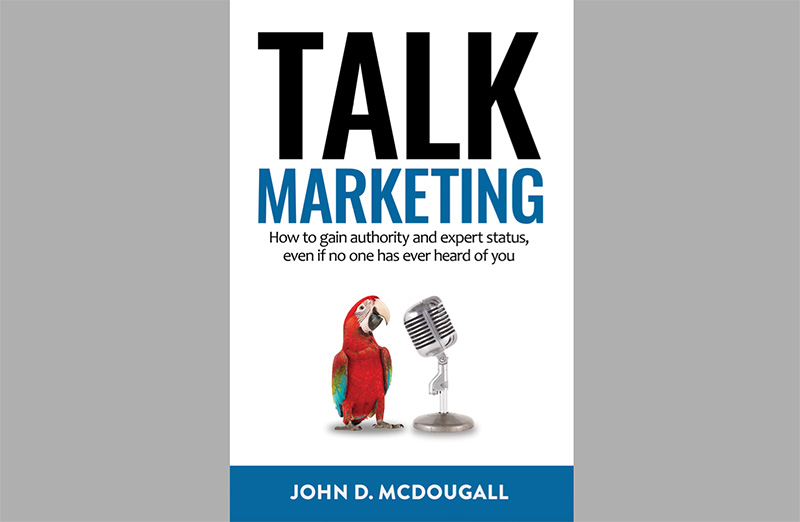What follows is the introduction to our forthcoming book, Talk Marketing – How to Gain Authority and Expert Status, Even If No One Has Ever Heard of You. As explained in this introduction, the book was written entirely by podcasting, and then cleaned up and edited into book form. You can do this too, and the next series of blog posts on TalkMarketing.com will include the podcasts that we recorded, and the edited transcripts from those podcasts that make up the bulk of the Talk Marketing book.
Introduction
This book is intentionally short — to show you just how easy it is to use the power of your voice to make content, which can be repurposed into blog posts, eBooks, print books, and more.
It’s also short, so it will be ridiculously easy to carry around to conferences and use as a direct mail piece. A compact book is much more tempting for your prospects to read and travel with. A book that gets read is more likely to turn into leads.
My first book, “Web Marketing on All Cylinders,” took me two to three years to write and was 420 pages long. It even got the honor of being a college textbook for five years at North Shore Community College. My next book “Content Marketing and SEO For Law Firms,” took one to two years to write.
Both books have generated a lot of business, like leaving a small speaking gig in New York with $11,500 a month in SEO sales, but if I could go back in time, I would have written a short book first. And that’s what I’m advising you to do. If you are already blogging and need content for SEO, even a simple eBook can fuel your marketing with added authority.
For the average business owner who is not used to writing books, I suggest you avoid the hell most people go through, thinking they must write a full-size heavy-duty book their first time out of the gate, and instead, use these tactics to write a short one.
I was at the Next Level Business Marketing Mastermind in Florida earlier this week. I woke up at 4:00 in the morning and had a sudden burst of energy to get this podcast-driven book going. I had ninety percent of the interview questions in less than two hours. I did a few more similar morning strategy sessions but spent less than 24 working hours total on this project.
I also scripted a few of the most important answers because I wanted the podcasts to be a little tighter than a loose interview. I usually don’t do that for podcasts, but I wanted to make sure the flow of the conversation got the main points across clearly and succinctly.
For this book, we edited out the interviewer and speaker identification and turned the transcripts into prose, but if you like, you can just clean up the transcripts and use them in their raw form to create a quick ebook or book. Either strategy allows you to turn conversations into valuable and persuasive content.
We’ve also included some writing tips to help you turn podcasts into prose. But again, you don’t have to create prose. Your podcast transcripts can be used independently, especially for blog posts where the podcast player is at the top, and the transcript is below. That lets you save time and create powerful content. Content that can blow the roof of your Google rankings, social media, email marketing, sales outreach, brand perception, and marketing in general.
Here is the final length of each podcast that made the main content for this book:
- Introduction to Talk Marketing for Creating Powerful Content 9:25
- How to Start a Podcast That Generates Leads 22:44
- How to Squeeze the Most Juice Out of Your Podcast Marketing 15:49
- How to Start and Optimize a YouTube Channel 28:02
- How to Start a Blog and Optimize It for SEO 14:13
- Using the Authority Content Flywheel for Advanced Digital Marketing 7:45
- How To Build a Better Brand Strategy Using Talk Marketing with Mike Cappuccio 28:50
All in all, that’s less than eight hours of prep work for concept ideation, scripting, and writing the introduction. The podcasts took us about two hours to record, and we did them all at once, other than the 28-minute client interview.
At that point, we handed off the transcripts to a writer who turned them into prose. It took me about six hours to playback around 16,000 words of the newly made prose using the MS Word read-aloud feature so I could make some edits and add a few small things.
After editing, the main part of the book was 16,749 words, and we added a client interview of 5,567 words. Then, we brought in 4,657 words of samples from other clients’ podcast transcripts and a list of resources. To show the diversity and depth of topics discussed in this type of marketing, we used samples from an HVAC company, a bank, a pest control specialist, and a personal injury lawyer.
In the end, the book is 31,725 words, which is great for a small but powerful book. Even 10,000 to 20,000 words would be acceptable for a gift book. Publishers prefer 60,000-word business books, but that often means half of the content is filler when the most important stuff can be expressed in less than half of that and save people lots of time. I’m self-publishing, so I have complete control and, if I want, can give thousands away as a branding tool without having to buy them from the publisher.
So, you can spend as little as a few hours brainstorming and a couple of hours doing podcast interviews. Then, you can hand the podcasts to your team to have transcribed and posted as blog posts or turned into prose for a book while you get back to running your business or having a margarita.
In contrast, people spend weeks or months generating content, and they pour years of their lives into writing books. That’s great for many creative endeavors, but you can write a book without that intense time commitment. Want to see how we did it? Then, dive in.

